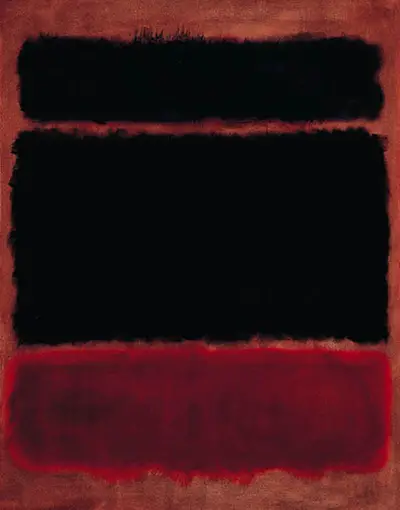Rothko loved Aeschylus' tragedies and Nietzsche's conception of the origin of tragedy, and because the act of painting put high drama in his life, he insisted that people see his paintings, including the black paintings, as dramatic. And some of them can be dramatic, of course, in the colloquial sense of "exciting". But true drama is a narrative structure involving the reversal of fortune, or at least some sense that this reversal has happened or can happen, and though drama is possible in an abstract painting, it requires specific elements. In a canvas by Pablo Picasso or Juan Gris, for instance, a play of forms is set in motion across the picture plane, and as in a jazz improvisation, people perceive the peril of failure, a collapse of integration, in the evolving dynamic and are thrilled when the composition is particularly successful.
Black in Deep Red, 1957 follows the characteristic format of Mark Rothko's work, in which stacked rectangles of color appear to float within the boundaries of the canvas. By directly staining the canvas with many thin washes of pigment and paying particular attention to the edges where the fields interact, he achieved the effect of light radiating from the image itself. This technique suited Rothko's metaphysical aims: to offer painting as a doorway into purely spiritual realms, making it as immaterial and evocative as music, and to directly communicate the most essential, raw forms of human emotion. His classic paintings of the 1950s are characterized by expanding dimensions and an increasingly simplified use of form, brilliant hues, and broad, thin washes of color. In his large floating rectangles of color, which seem to engulf the spectator, he explored with a rare mastery of nuance the expressive potential of color contrasts and modulations.
Rothko would push the world of abstract art into a pure environment in which no elements of reality could be found. He wanted his viewers to be taken over entirely, and so many of his paintings would be wider and taller than most humans. He also took great care in how they were exhibited, making sure there was plenty of space between each artwork. Once his items were sold privately, he would relinquish all control and that must have been hard for him. In recent years some of his artworks have achieved sale prices in the many millions of dollars, and some even see contemporary art as a genuine investment opportunity. Thankfully, enough artworks have been acquired by public art galleries and museums that we can still see many of his paintings in person ourselves, often entirely for free.

